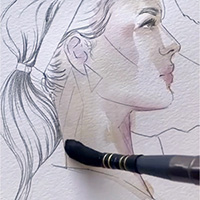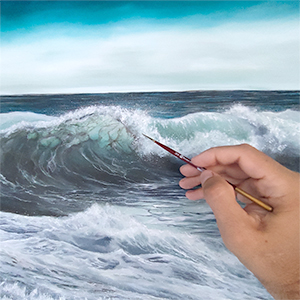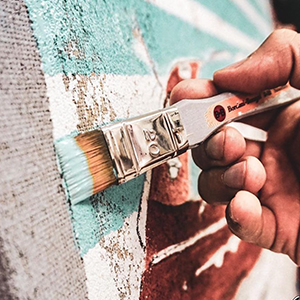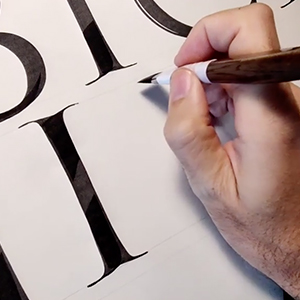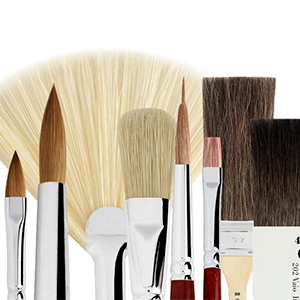Decoupage: la guida completa
Decoupage: The Complete Guide
The decoupage technique is a decorative method that replaces painted images with perfectly cut-out images paired with decorative backgrounds and finishes, transforming objects and furniture into decorative works.
Suitable for everyone due to its simplicity of execution, decoupage has experienced a true explosion in popularity over the last few decades, with multiple variations emerging. Generally overlooked by artists and loved by crafters and decorators, the decoupage technique in recent years has seen various techniques "joining forces". These have overlapped with the decouper (cutting out) technique and have made the creations of numerous practitioners even more complex.
Initially, decoupage was applied to furniture; today, it is used to decorate various objects made of different materials such as wood, fabric, glass, and metal. It has become a technique accessible to everyone, and the advantage of restyling and recycling basic supports makes it perhaps less-known, but certainly an interesting art form.
Le tecniche più diffuse sono: pittorico, effetto affresco, craquelé, trompe l'oeil, découpage base con carta, découpage con pennelli o pastelli, découpage con e su tessuto.
The most common techniques include: painted decoupage, fresco effect, crackle finish, trompe l'oeil, basic decoupage with paper, decoupage with brushes or pastels, and decoupage on fabric.
Applying cutouts using vinyl glues and various finishing varnish layers make this technique suitable for revising and using on all types of absorbent surfaces such as canvas, wood, terracotta, and papier-mâché, as well as on all non-absorbent supports like metal, marble, glass, and plastic.
Backgrounds can be created using various decoration techniques, from faux wood to faux marble, through mosaic imitation, and especially the use of multiple materials in the artwork such as pressed flowers, fabric, and textured papers can truly bring about works of artistic interest.

The history of Decoupage
Decoupage is a decorative technique whose name derives from the French word "découper," meaning to cut out.

This technique originated in the Middle Ages in Europe, primarily used by monks to embellish their manuscripts: images were painted, and only certain parts of the work were cut out and covered with precious fabrics and special papers, all while preserving the painstakingly written text.
Modern decoupage, as we know it, has its origins in China in the 16th century: precious and lightweight painted rice papers were applied to furniture and then lacquered.
The process, aimed at making furniture and objects more precious through multiple layers of very thin and glossy lacquer, allowed the paper to be fixed and protected over time, creating exquisite decorative effects.
With trade routes established by the Maritime Republics in the late 17th century, the first objects decorated with this technique arrived in Europe, initially referred to simply as lacquering.
Extremely expensive and with production insufficient to meet demand, this importation was absorbed by skilled Venetian furniture artisans who offered a more economical alternative.
Thus, the so-called "Venetian poor art" was born, which involved cutting out oriental prints and gluing them with layers of sandarac finish (a natural resin).
The technique then spread to France and England, becoming famous in the 17th century when PAPIER PAINT and PRINT ROOM became popular: the former featured delicate natural subjects painted in gouache and then glued to walls and furniture, while the English version glued prints depicting European cities directly onto walls and embellished them with subsequent workmanship, in the homes of aristocrats.
The style changed significantly over time, transitioning from depictions of rural scenes, flora, and fauna to a golden age in the Art Nouveau period and the 1940s.
Decoupage can be considered a technique that preceded the creation of modern subject wallpapers. In the 1990s, decoupage returned to fashion, becoming known to a vast number of people, driven by the trend of upcycling furniture and objects, and especially by the ease of execution with the use of increasingly affordable materials, making this evolution even faster.
The technique of Decoupage
The decoupage technique is not difficult and is suitable for everyone, even beginners. The steps of the basic technique are very simple:
1. Preparation of the support:
The support should be prepared with chalk or primer to be as smooth as possible, ensuring the application of color, typically matte acrylic for decoration, is even.
For this step, brushes with natural bristles or synthetic filaments are ideal, allowing for multiple passes without visible traces in the paint.
2. Gluing the illustrations:
On this dry base, proceed to glue previously carefully cut-out images with vinyl glue, dampened with water, pressing on the surface to avoid air bubbles. Brushes with white synthetic bristles, elastic and rigid, are the best choice because they allow for significant pressure without scratching the damp paper.
The application of glue with common decoupage papers is usually both on the base and on top, for maximum durability over time.
3. Decoration:
Once completely dry, decorate the entire surface using the technique that best suits your project: shading with watercolor pencils, antiquing, and special coloring effects can be applied at this stage.
4. Application of varnish:
The first layer of final varnish, usually in gel consistency, should be applied with soft and light brushes that do not leave traces.
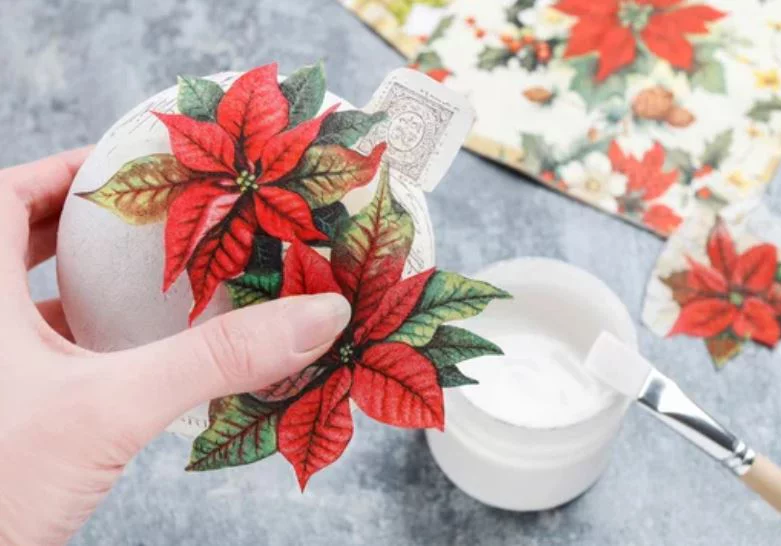
5. Removing the paper reliefs:
Once fully dried, for a perfect finish, proceed to remove the paper reliefs by sanding the surface with fine sandpaper.
6. Application of final varnish:
After carefully removing any resulting dust, proceed with several layers of final varnish with the desired finish, always ensuring optimal drying time between each application.
All finishing work with bitumen, shading with colored waxes, crackle effects, and anything oil-based should be done once the work is completed, to allow the oils to dry through oxidation upon contact with air.
What brushes to choose for Decoupage?
The brushes for decoupage are synthetic brushes, typically large-sized, with stiff bristles and medium to low absorbency because dense primers, glues, and varnishes are often used for this technique.
Brushes for varnishing in decoupage technique: series 300

The series 300 brush has a medium-short bristle that allows for application of medium-dense colors, mediums, and adhesives, leaving a short and noticeable stroke. Ideal for decorative work, it is used for acrylics, vinyl glues, application of papers, and decorations on porous surfaces such as walls. The handle is short and manageable, with a hole at the end.
For all varnishing of final layers, for perfect results, synthetic brushes with light and soft fibers can be chosen, with a highly conical section, which make the brushstroke elastic at the base and very light at the tip:
- Series 302 brush: a simple brush with gold filament of medium length, with a short handle in pearl gray water-based varnished wood and a stainless steel ferrule. The gold fiber, soft and elastic, is ideal for acrylics, preparation of watercolor backgrounds, gouache, and varnishing without thickness. The short handle is manageable, and the stainless steel ferrule is resistant to oxidation that occurs with long soaks in water or solvents.
- Series 302 is used as a replacement for natural Ox Hair, with the same characteristics of lightness and elasticity. The medium-long fiber maintains its shape over time and allows for application of backgrounds and final varnishes without leaving traces. The brushstroke is wide and with a medium release of water and color, thinner when used flat. The handle has a special water-based semi-transparent varnish that resists immersion better. The grip is traditional and light, with a hole in the back.
For those who prefer natural bristles, an option is the series 303 brush with white bristle. Extra white hog bristle is the thinnest among natural bristles, tough and resistant, moderately elastic and flexible with excellent color retention. It is ideal for pasty techniques where color movement is required and with a medium-slow release, such as acrylics, tempera, water-based and solvent-based varnishes.
Brushes for varnishing in decoupage technique: series 200

Another very similar example is the pennellessa series 207: a white synthetic fiber, less soft than the previous one, which allows for application of medium-dense colors, mediums, and adhesives without leaving too noticeable traces in the color material.
Its medium absorbency also allows for good cleaning from thickening agents such as polymers in vinyl glues.
Ideal for decorative work, it is used for applications with acrylic paint, vinyl glues, patinas, and decorations even on textured and rough surfaces such as walls. Its resistance to wear is high, and the handle is short and manageable, with a hole at the end.
Brushes for decoration in decoupage: here's what to use

The fiber of series 97, series 98 and series 99 brushes is also suitable for this technique as it is characterized by a straight structure with high rigidity, low absorbency, and quick release for fluid varnishes. It maintains excellent elasticity in the brushstroke and does not leave traces that are too difficult to remove with sanding.
The heads of these white synthetic brushes are flat in series 97, oblique cut flat in series 98, and tampon-shaped in series 99: this particular shape, specially created for stenciling, is ideal for brushed applications of patinas and colored waxes, creating very interesting decorative effects.
The series 99 stencil brush with short and even bristles and an extra-short handle is ideal for gripping almost perpendicular to the work surface, to adhere decoupage and DIY elements; all the brushes mentioned in this category are also suitable for decoration work on frames, furniture, and other rough and porous surfaces that require the use of multiple layers of varnishes and lacquers.
Brushes for decoupage: Borciani e Bonazzi sets

We have also created two specific sets for decoupage and decoration in general:
- The Pisa Collection set in white synthetic bristle, consisting of two flat brushes, one flat brush, and one angled brush. The white synthetic bristle of the brushes is elastic and tenacious, ideal for decoupage varnishes, water-based varnishes, flatting varnish, acrylic varnish, crystal lacquer, chalk paint, and others.
- Il The Torino Collection set consists of 4 brushes specifically designed for decoration and facilitated painting, for the execution of shapes and motifs that often refine the decorations of decoupage works. The brushes are made of gold synthetic bristle with a nickel-plated brass ferrule and a short handle. The short handle is ideal for its maneuverability for small and precise work. The handle is traditional and lightweight. The handle is lacquered to protect the wood from deformation due to prolonged immersion in water or solvents.

























